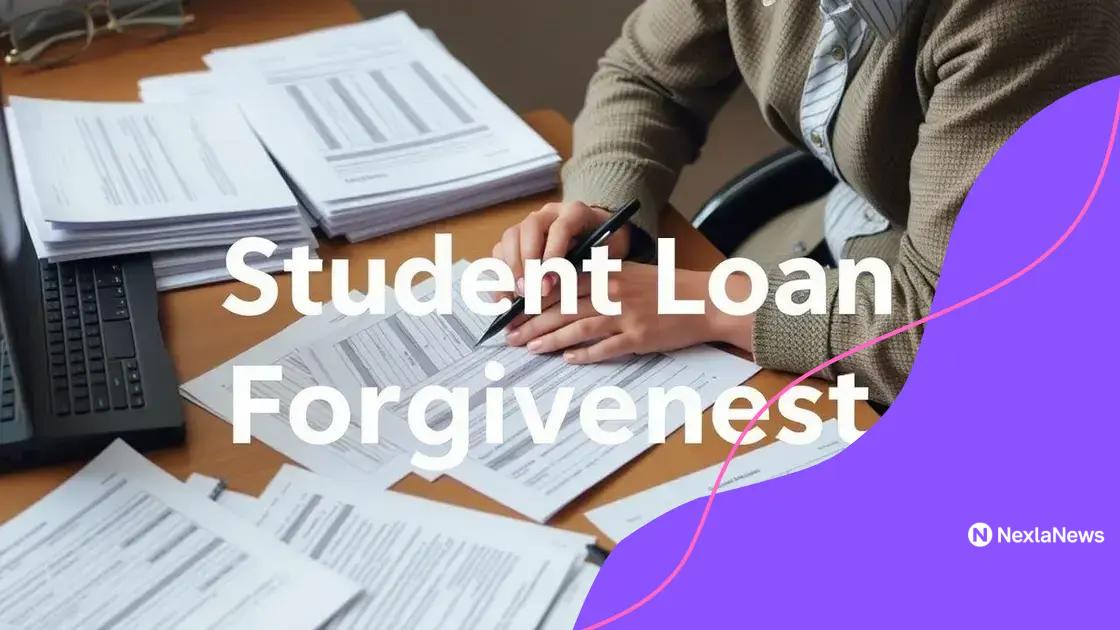Student loan forgiveness: how to navigate the process

Student loan forgiveness programs target federal loans, allowing qualified borrowers to reduce or eliminate their debt based on specific eligibility criteria and application processes.
Student loan forgiveness often feels like a distant dream for many borrowers. But what if I told you that there are real pathways to lighten your financial load? Let’s dive into what it takes to navigate this complex process together.
Understanding student loan forgiveness options
Understanding student loan forgiveness options is crucial for borrowers seeking relief from their debts. Many people don’t realize that there are various paths to forgiveness, each with its unique requirements.
Types of Forgiveness Programs
There are several programs available for student loan forgiveness. Each program targets different groups of borrowers based on their profession, repayment plan, or public service commitment.
- Public Service Loan Forgiveness (PSLF): Designed for those working in public service jobs, this program forgives remaining loans after 120 qualifying payments.
- Teacher Loan Forgiveness: Teachers who work in low-income schools may qualify for forgiveness up to $17,500.
- Income-Driven Repayment (IDR) Forgiveness: After 20 or 25 years of qualifying payments, borrowers may have their loans forgiven under certain IDR plans.
Eligibility Criteria
To qualify for forgiveness, borrowers must meet specific eligibility criteria. Understanding these requirements is vital for maximizing your chances of approval.
For instance, PSLF requires borrowers to make payments under a qualifying repayment plan while employed by a qualifying employer. On the other hand, Teacher Loan Forgiveness demands proof of teaching service in eligible schools. These details can often affect your ability to achieve forgiveness, so it’s essential to keep accurate records of your employment and payments.
Additionally, it’s important to know that not all student loans qualify for forgiveness. Federal loans are generally eligible, but many private loans are not. Therefore, before pursuing any program, ensure you understand the type of loans you possess.
Moreover, keeping up-to-date with any changes in federal legislation regarding student loan forgiveness can help you navigate your options effectively. Being proactive in seeking information can empower you to make informed decisions about your financial future.
Eligibility requirements for student loan forgiveness
Determining the eligibility requirements for student loan forgiveness is a key step for many borrowers looking to ease their debt burden. Different programs have varying criteria that must be met to qualify for forgiveness.
Common Eligibility Criteria
Borrowers need to understand several essential factors to evaluate their eligibility. Here are some of the primary requirements common across many forgiveness programs:
- Type of Loan: Only federal student loans are eligible for most forgiveness programs. Ensure your loans fall into this category.
- Repayment Plans: Many programs require borrowers to be on specific repayment plans, such as Income-Driven Repayment (IDR) plans.
- Employment Status: For programs like Public Service Loan Forgiveness (PSLF), working in a qualifying employment setting is crucial.
Additional Factors to Consider
It’s also vital to focus on the duration of your payments. Programs like PSLF require that you make 120 qualifying payments, while others may have different timeframes. Additionally, review the documentation required for your employer or job role, as it can vary significantly between programs.
Maintaining accurate records of your payments and employment will support your application. Not all borrowers realize the importance of tracking this information, which can lead to missed opportunities for forgiveness.
Lastly, borrowers should stay informed about changes in legislation and policy regarding student loan forgiveness. The rules can shift, and new programs may emerge, which could enhance your options for relief.
Application process for student loan forgiveness

Understanding the application process for student loan forgiveness is essential for borrowers hoping to reduce their financial burden. Applying for forgiveness can seem overwhelming, but breaking it down into simple steps can make it manageable.
Gather Required Documentation
The first step is to gather all necessary documentation. This includes your loan information, employment records, and proof of qualifying payments. Having everything organized will streamline your application process.
- Loan Information: Know the details of your loans, including the type and status.
- Employment Records: Collect pay stubs or work letters that show your employment with a qualifying employer.
- Payment History: Keep track of your payment history to prove your eligibility for forgiveness.
Completing the Application
Once you have your documentation, the next step is to complete the appropriate application form. For Public Service Loan Forgiveness (PSLF), you typically need the PSLF application, which you submit to your loan servicer. Make sure to fill out all sections carefully to avoid delays.
It’s also wise to double-check the information before submitting. Simple errors can lead to complications in processing your application, so take your time to review everything.
After submission, you will receive confirmation from your loan servicer. Keep this confirmation for your records, as it can serve as proof that you applied for forgiveness.
Finally, be prepared for potential follow-up questions from your loan servicer. They may need further information or clarification, so staying communicative can help expedite the process.
Common myths about student loan forgiveness
Many borrowers hold common myths about student loan forgiveness that can lead to confusion and misinformation. Understanding the facts behind these myths is essential for making informed decisions about your financial future.
Myth 1: All Loans Are Eligible for Forgiveness
One of the most significant misconceptions is that all types of student loans can be forgiven. In reality, only federal student loans are typically eligible for forgiveness programs. Private loans usually do not qualify, and borrowers should check the specific conditions of their loans.
Myth 2: Forgiveness is Automatic
Many believe that simply applying for forgiveness guarantees approval. However, borrowers must meet specific requirements and actively manage their application process. Just submitting an application doesn’t ensure forgiveness; you need to provide the right documentation and maintain eligibility.
- Documentation is key: You must submit documents like proof of employment and payment history.
- Periodic verification: Your eligibility can be reviewed periodically, and maintaining it is crucial.
Myth 3: You Will Never Pay Your Loans Again
Another myth is that once your loans are forgiven, you won’t have to think about them again. However, it’s important to note that any borrower who does not meet the requirements or maintain their status may find themselves responsible for the remaining debt.
Being proactive about your loan management is vital. Understanding the fine print and staying informed of changes in forgiveness policies can aid you in keeping your obligations in check.
Finally, many assume that forgiven amounts are tax-free. While some borrowers may not face taxes on forgiven amounts, others could have tax liabilities depending on the current tax laws. As legislation can change, consulting a tax professional ensures you understand your financial obligations.
Impact of student loan forgiveness on credit
The impact of student loan forgiveness on credit is often a concern for borrowers considering this option. Understanding how forgiveness works can help you prepare for any changes in your credit profile.
Short-Term Effects on Credit Score
Initially, when a portion of your loan is forgiven, you may see a positive effect on your credit score. This is because your overall debt load is reduced, which can improve your credit utilization ratio. A lower debt means a better credit score.
Long-Term Effects and Considerations
However, there are factors to consider. If you fall behind on your payments while applying for forgiveness, your credit score could take a hit. Maintaining timely payments during this process is critical.
Additionally, when your loans are forgiven, the amount forgiven may be reported to credit bureaus. However, as long as there are no missed payments reported, the impact on your credit score should remain minimal.
- Credit Mix: Having a variety of credit types can help your score, but if student loans are your primary type of credit, losing them could affect your score.
- Length of Credit History: Length of time accounts are open is important. If student loans are closed, it may reduce your average account age.
Keeping a close watch on your credit report during this time is essential. Regular monitoring will help you catch any unexpected changes. Being proactive can help you address issues before they affect your financial future.
In summary, understanding and navigating the student loan forgiveness process is essential for borrowers. By knowing the eligibility requirements, debunking myths, and being aware of how forgiveness impacts your credit, you can make informed choices. Taking proactive steps towards applying for forgiveness and managing your loans can lead to a brighter financial future. Remember, staying informed is key, and seeking professional advice when needed can help you along the way.
FAQ – Frequently Asked Questions about Student Loan Forgiveness
What types of loans are eligible for forgiveness?
Only federal student loans are generally eligible for forgiveness programs; private loans usually do not qualify.
Is the forgiveness process automatic?
No, borrowers must actively apply and meet specific requirements to qualify for any forgiveness program.
How does loan forgiveness impact my credit score?
Forgiveness can improve your credit score by reducing your overall debt, but missed payments during the process can harm it.
What documentation is needed for the application?
You will need loan details, employment verification, and proof of qualifying payments to complete the application for forgiveness.
